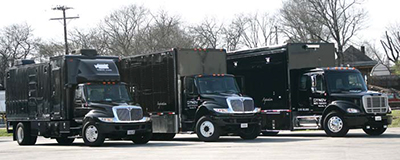Mobile Sports Production Eyes 4K

Nashville mobile production company TNDV is planning for a 4K future.
BROOKLYN, N.Y.— Ultra HDTV and 3G/1080p will be popular installation choices for U.S. sports production trucks by 2016. 1080i mobile sports production will endure, but 720p is on the way out.
These are three of the findings in white paper from The Josh Gordon Group, “How 4K UHDTV, 3 Gbps/1080p, and 1080i will shape the future of sports television production.” The white paper, which was sponsored by Miranda Technologies, was based on 538 responses from U.S. “high-end sports production professionals working with mobile truck production.” Almost 75 percent of those who responded are involved with sports truck productions.
“We commissioned this survey to better understand technology trends in the space,” said David Cohen, Miranda Technologies’ director of marketing communications. Miranda funded the white paper not just for business intelligence reasons, but also because “sports production has long been a driver for technological advancement in our industry.”
‘REASONABLE PREDICTIONS’
The Josh Gordon Group’s strategy in predicting sports studio and mobile production trends to 2016 is to consider “the number of years within which reasonable predictions of the future can be made, based on what we know about the present.” This knowledge, in turn, was drawn from the 538 responses to its survey.
The CliffsNotes’ version: 1080i is the current preferred sports production format, although producers are also using or testing SD-SDI, 720p, 3G/1080p, IP, 3D, 4K and even 8K. Just under 37 percent of sports mobile operators surveyed expect to build 3G/1080p trucks three years from now and 30.8 percent expect to be building 4K, while 21.2 percent are sticking with 1080i.
Of the current 720p users surveyed (both studio and mobile), only 6.6 percent expect to be using this format in 2016. In contrast, 68.4 percent were evenly split between using 3G/1080p and 4K.
Get the TV Tech Newsletter
The professional video industry's #1 source for news, trends and product and tech information. Sign up below.
Gordon was clearly astounded by the strong support for 4K. “If I told you that there was a new production format that very few facilities could support, had no way to get live signals using it to the home, and no business model to support the expense of limitation, would you expect it to be one of the most popular production formats in use three years from now?” he said. “Against the odds, this is how the respondents filled out the survey.”
JUST FOR U.S.
Reaction to The Josh Gordon Group white paper, as surveyed by TV Technology for this article, was generally positive.
“I do think these are reasonable predictions,” said John Carter, senior product manager for production switchers for Snell.
Bob Caniglia, Blackmagic Design`s senior product manager for Eastern North America, said, “I see a very similar trend,”
Nigel Spratling switcher business development manager for Ross Video said, “We expect to see high-end broadcasters using 4K to cover premium sporting events in the future.”
That said, “we have to remember that this white paper only reflects U.S. sports production,” said Eric DuFosse, Grass Valley vice president of live solutions. “At the world level, we are still at a point where 50 percent of broadcasters are still using SD.”
Speaking from a truck operator’s perspective, Nic Duggar, president of TNDV— which operates four mobile production based out of Nashville—said that the time is right for his company to move to 4K. “We’ve paid off the investment we made in 1080i trucks a few years, and now we’re ready for the next generation of mobile production technology,” Duggar said. “4K is clearly the next big leap. Besides, as long as our 4K units are backwards compatible—and they will be—they will be able to handle 3G/1080p and 1080i.”
‘OPENTRUCK’
The general acknowledgement of 4K’s eventual adoption in sports mobile production was tempered by a shared concern; namely that current 4K equipment is not standardized.
“No one has even standardized on one 4K I/O specification,” said James Stellpflug, vice president, sports products for the Americas region for EVS. “This makes it difficult for today’s truck builders to decide which 4K equipment will be ‘future-proof’ three years from now.”
And don’t forget the all-important signal distribution issues.
“There’s also the issue of conflicting in-truck architectures, right down to the connections and signal protocols to be used,” Spratling said. “My company tackled this kind of problem a few years ago when we came up with the openGear open architecture platform for truck racking and terminal equipment; which is now used by 65 manufacturers. We are trying to do the same thing on a larger scale with ‘openTruck,’ which could help develop an open architecture for 4K mobile production.”
In October, Ross acquired mobile production company Mobile Content Providers and reportedly plans to develop a platform similar to its openGear technology, building products according to company specs but making the architecture available to industry partners, according to market research firm Devoncroft.
The gaps in current 4K standards and available products notwithstanding, the notion the 3G/1080p and 4K are the formats of sports mobile production’s future is acceptable to mobile truck operators such as Duggar.
“We invested a lot of money making the leap to HD and 1080i, and it has proven to be worthwhile,” he said. “Although I agree that 3G/1080p will be a big player in the next few years, I do see the road open to 4K. In investing in new equipment, I am looking for something that clearly takes my company to the next level—and 4K does that.”
James Careless is an award-winning journalist who has written for TV Technology since the 1990s. He has covered HDTV from the days of the six competing HDTV formats that led to the 1993 Grand Alliance, and onwards through ATSC 3.0 and OTT. He also writes for Radio World, along with other publications in aerospace, defense, public safety, streaming media, plus the amusement park industry for something different.

